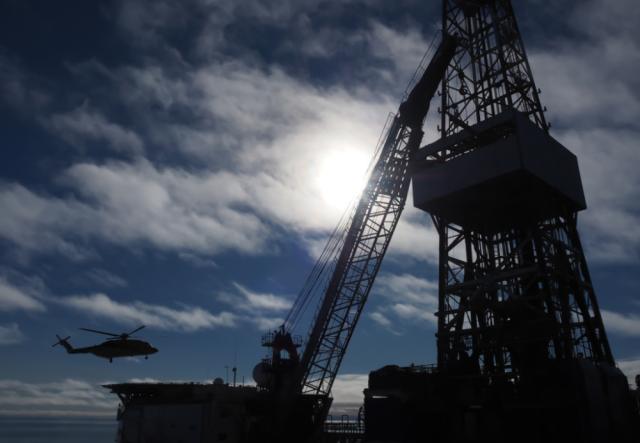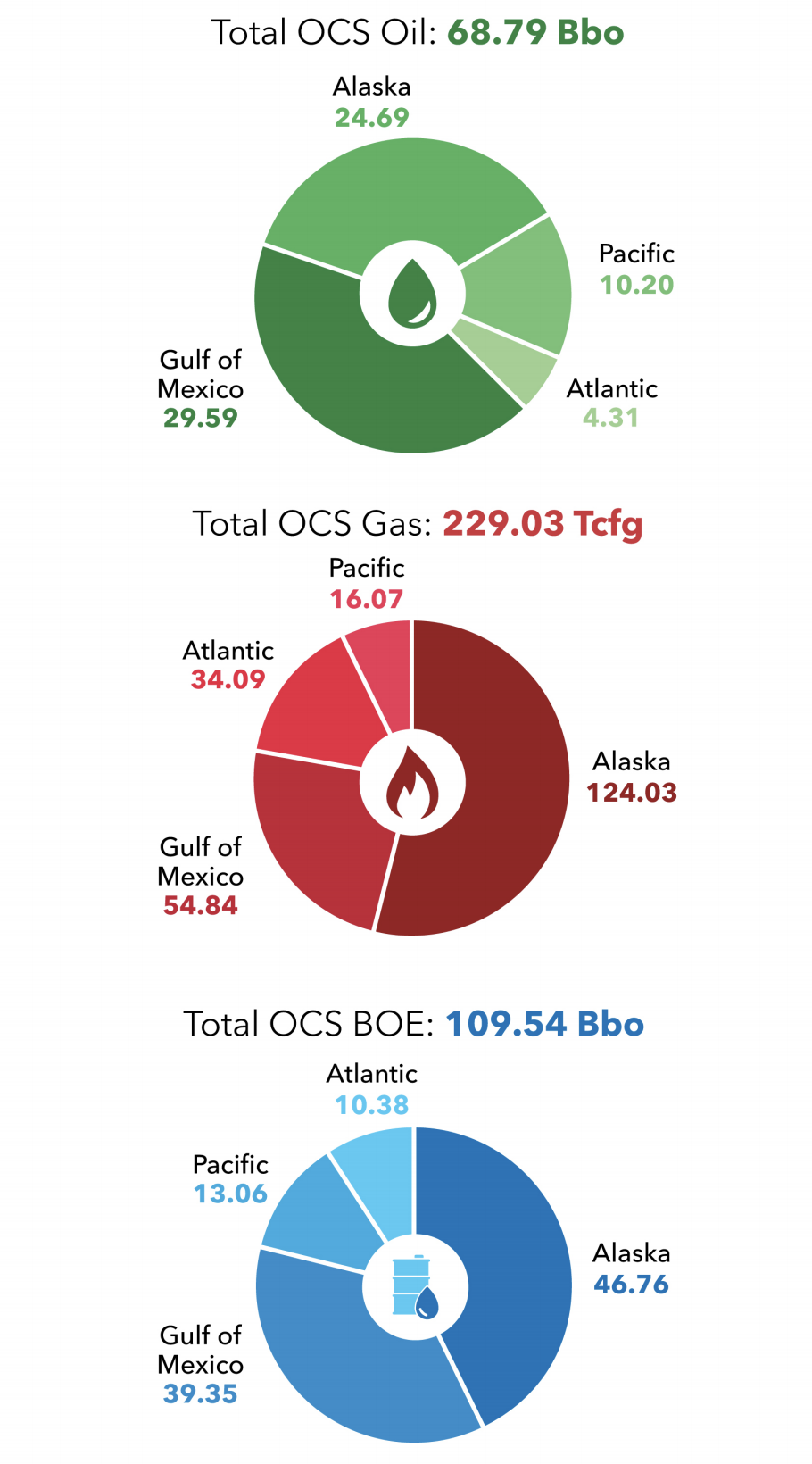
A helicopter lands on a drilling rig in the Gulf of Mexico. (Source: Shutterstock.com)
[Editor's note: This article was updated at 4:27 p.m. May 27.]
The amount of undiscovered technically recoverable oil and gas resources (UTRR) in the U.S. Gulf of Mexico’s (GoM) federal waters is shrinking, according to a report released by the Bureau of Ocean Energy Management (BOEM).
“Of BOEM’s four regions, the 2021 estimates of UTRR for the Gulf of Mexico showed the most change from 2016, due in part to the refinement of field size distributions and the estimated number of prospects for some mature geologic plays, particularly on the shallow water shelf,” BOEM said in a statement.
Data show risked UTRR mean estimates for oil fell 38% to nearly 30 billion barrels (Bbbl), while UTRR dropped by 61% for natural gas in the GoM where 30 geologic plays were assessed. Most of the GoM plays experienced a drop in the number of undiscovered fields, BOEM spokesperson Bev Winston told Hart Energy. “The Cenozoic plays, in particular, had the largest concentration of reductions in the number of prospects.”
However, the region—which today accounts for about 17% of total U.S. crude oil production and 5% of its total dry gas production—saw an increase in UTRR in several geologic plays in the Mesozoic, according to the BOEM. Of the Mesozoic plays, “The Smackover play is assessed to have the largest increase in resources since our last assessment with just over a 1.75 Bboe increase in mean UTRR,” Winston said. “The BOEM assessment of the Smackover has been updated with additional analog data from onshore development. BOEM expects that many of the companies active in the deepwater GOM have some interest in Mesozoic plays.”
The latest U.S. Outer Continental Shelf (OCS) resource assessment, published every five years by BOEM, is based on analysis of geologic plays across the GoM as well as the Alaska, Atlantic and Pacific OCS regions using geophysical, geological, technological and economic data available as of Jan. 1, 2019. Excluded from the assessment, which centered on conventional reservoirs and recovery techniques, were hydrocarbon resources capable of being recovered from known and future fields using enhanced recovery techniques.

“After more than 60 years of OCS exploration and development, BOEM estimates that greater than 60% of OCS resources remain undiscovered,” BOEM said in the report. “Approximately 33% have been produced, with 3% remaining as discovered reserves.”
In all, the assessment showed mean UTRR estimates on the OCS dropped by nearly 22 Bbbl of oil and about 99 Tcf of gas compared to the 2016 assessment. BOEM estimates put UTRR for oil at 68.79 Bbbl and 229.03 Tcf for gas. Besides additional data acquired since the last assessment, BOEM attributed some of the resource estimate changes to assessment methodology updates.
“On a BOE basis, 43% of the potential resources are within the Alaska OCS. The Gulf of Mexico OCS ranks second with 36%,” according to the report. “The Pacific is third among the regions in terms of oil potential and fourth with respect to gas. The Atlantic OCS ranks third when considering gas potential and fourth in terms of oil.”
While the GoM was the area with the most notable changes, it was also among the areas BOEM believes companies have a good chance of finding oil and gas, particularly the Cenozoic shelf plays because of their maturity and long history of development, BOEM said.
“The petroleum systems in these plays are proven to exist and individual prospects are relatively shallow with existing high-quality geophysical imaging,” Winston said. “These elements contribute to the BOEM assessment of a relatively higher probability of success for these plays.”
BOEM also noted that it develops analog plays to cover uncertainties related to frontier portions of the four regions assessed due to sparse data.
“For mature areas with significant amounts of data, such as the Gulf of Mexico and Southern California, geologic plays are analyzed by combining the subjective methodology using historical trends with a discovery-based approach to account for the existing discovered pools,” BOEM said.
Alaska: BOEM reported a drop—3.95 billion barrels of oil equivalent (Bboe) in UTRR for the Alaska OCS region where 73 geologic plays were assessed. The decline, to a mean risked UTRR of 24.69 Bbbl of oil and 124.03 Tcf of gas, was attributed mostly to “reassessment of risk profiles in the Beaufort Sea Planning Area.”
However, BOEM said the UTRR for the Chukchi Sea rose slightly, reaching 15.72 Bbbl and 79.58 Tcf. “The relatively small change (an increase of less than 3%) in the mean UTRR volume in the Chukchi Sea was due to reassessment of geologic risk within the framework of the updated BOEM methodology,” Winston said.
Atlantic: New data from global analog plays along with changes to play and prospect risk profiles were behind the 10% fall in UTRR in the Atlantic OCS to 10.38 Bboe. Here, BOEM assessed 10 geologic plays, concluding the region has mean UTRR estimates of 4.31 Bbbl and 34.09 Tcf.
Pacific: BOEM assessed 43 geologic plays on the Pacific OCS. Results show mean UTRR estimates did not change much, coming in at an estimated 10.2 Bbbl and 16.07 Tcf.
The report also assessed risked undiscovered economically recoverable resources (UERR) utilizing a range of oil and gas price points, while accounting for exploration and development costs and commodity prices.
“Notably, UERR gas resources in Alaska have declined since 2016 due to the implementation of an increased transportation tariff associated with the presumed movement of gas via overland pipelines and delivery by liquefied natural gas tanker systems,” BOEM said in the report.
“In the Atlantic OCS, UERR gas volumes were negatively impacted by assumptions associated with geologic field size distributions and from updated development costs,” it added. “In the Gulf of Mexico, UERR has decreased proportionally with the sizeable drop in UTRR. In the Pacific OCS, the aggregate impact on UERR from changes to the economics inputs is largely neutral.”
BOEM said it plans to release additional details on the economics as well as geology, assessment methodology and geology in separate play-specific regional assessment reports.
Recommended Reading
Enbridge Closes First Utility Transaction with Dominion for $6.6B
2024-03-07 - Enbridge’s purchase of The East Ohio Gas Co. from Dominion is part of $14 billion in M&A the companies announced in September.
SCF Acquires Flowchem, Val-Tex and Sealweld
2024-03-04 - Flowchem, Val-Tex and Sealweld were formerly part of Entegris Inc.
Pembina Cleared to Buy Enbridge's Pipeline, NGL JV Interests for $2.2B
2024-03-19 - Pembina Pipeline received a no-action letter from the Canadian Competition Bureau, meaning that the government will not challenge the company’s acquisition of Enbridge’s interest in a joint venture with the Alliance Pipeline and Aux Sable NGL fractionation facilities.
Global Partners Buys Four Liquid Energy Terminals from Gulf Oil
2024-04-10 - Global Partners initially set out to buy five terminals from Gulf Oil but the purchase of a terminal in Portland was abandoned after antitrust concerns were raised by the FTC and the Maine attorney general.
DXP Enterprises Buys Water Service Company Kappe Associates
2024-02-06 - DXP Enterprise’s purchase of Kappe, a water and wastewater company, adds scale to DXP’s national water management profile.






